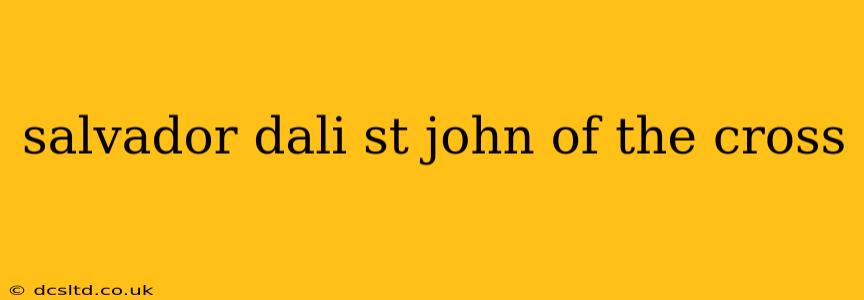Salvador Dalí's Crucifixion (Corpus Hypercubus), often referred to as St. John of the Cross, is far more than a simple depiction of a religious scene. It's a powerful testament to Dalí's unique brand of Surrealism, blending religious iconography with his signature exploration of dreams, the subconscious, and the complexities of human perception. This enigmatic masterpiece, painted in 1954, continues to fascinate and challenge viewers, prompting endless interpretations and discussions. This article delves into the complexities of this iconic work, exploring its symbolism, its connection to St. John of the Cross's mystical writings, and the artistic techniques Dalí employed to create this stunning and thought-provoking piece.
What is the significance of the hypercube in Dalí's "St. John of the Cross"?
The most striking element of Crucifixion (Corpus Hypercubus) is undoubtedly the hypercube, a four-dimensional cube projected onto a two-dimensional plane. This geometric form isn't just a random artistic choice; it represents Dalí's fascination with mathematical concepts and their relationship to spirituality and the divine. The hypercube symbolizes the transcendence of earthly limitations and the exploration of higher dimensions of reality, reflecting the mystical experiences described by St. John of the Cross. The Christ figure, seemingly suspended within this impossible structure, represents the fusion of the physical and the spiritual, the earthly and the divine.
How does Dalí's painting relate to the writings of St. John of the Cross?
St. John of the Cross, a 16th-century Spanish mystic and Carmelite friar, penned profound works exploring the spiritual journey towards union with God. His writings, filled with imagery of darkness and ascent, heavily influenced Dalí's artistic vision for this piece. The desolate landscape, the stark simplicity of the composition, and the almost ethereal quality of Christ's figure all echo the mystical experiences described by St. John of the Cross. The painting's focus on the spiritual rather than the physical aligns perfectly with the mystic's emphasis on inner transformation.
What are the key symbols in Dalí's "St. John of the Cross"?
The symbolism in Dalí's St. John of the Cross is multi-layered and open to interpretation. Beyond the hypercube, several other elements contribute to its powerful message:
- The Christ Figure: Depicted in a surprisingly passive and almost weightless manner, Christ's position within the hypercube suggests his transcendence beyond earthly suffering.
- The Desolate Landscape: The barren background reinforces the spiritual focus, drawing attention away from the physical world and emphasizing the internal journey of faith.
- The Perspective: The unusual perspective, often described as a "bird's-eye view," adds to the painting's surreal and dreamlike quality, enhancing the sense of transcendence.
- The Light and Shadow: The interplay of light and shadow adds depth and drama, creating a mystical atmosphere that further complements the spiritual theme.
What is the overall meaning and interpretation of Dalí's "St. John of the Cross"?
Dalí's St. John of the Cross is not easily categorized. It's a complex interplay of religious symbolism, mathematical concepts, and Surrealist aesthetics. The painting invites viewers to contemplate the nature of faith, spirituality, and the limits of human perception. It's a powerful visual representation of the mystical journey, bridging the gap between the earthly and the divine, the rational and the irrational. Ultimately, its meaning is open to interpretation, inviting ongoing dialogue and analysis. The enduring power of the piece lies in its ability to spark reflection and inspire awe, even decades after its creation.
What techniques did Dalí use in this painting?
Dalí masterfully employs his signature techniques to create the painting's surreal and dreamlike effect. His precise and meticulous brushwork, combined with a keen understanding of perspective and light, creates a stunning visual experience. The sharp contrast between the meticulously rendered hypercube and the soft, almost ethereal representation of Christ enhances the painting’s impact. Dalí's use of realistic details alongside the impossible geometry creates a tension that keeps the viewer engaged and continually interpreting the piece.
Why is Dalí's "St. John of the Cross" considered a masterpiece?
The enduring power of Crucifixion (Corpus Hypercubus) stems from its ability to seamlessly blend religious iconography with the visionary language of Surrealism. It's a masterful demonstration of Dalí's artistic skill, philosophical depth, and understanding of religious symbolism. The painting transcends its religious context, engaging with broader themes of perception, spirituality, and the human quest for meaning. It continues to resonate with viewers because of its complexity, its beauty, and its enduring ability to provoke thought and inspire awe. The impact of this painting on the art world, solidifying Dalí's reputation as a leading figure in Surrealism, is undeniable.
